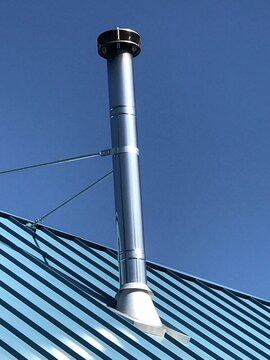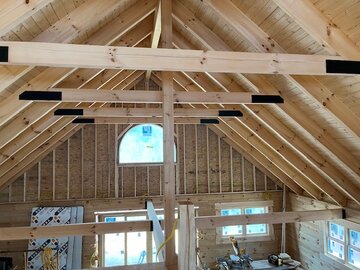Hi there! I am new ;-)
We are building a log home and would like to vent the flue pipe through the gable wall in the great room. The penetration is through the wall and pretty far up to miss the roof that is over the porch. Of course now we also have to miss the soffit.
My question is: Do you need to install the "T" for an outside connection directly mounted to the wall or can you go out with a length of pipe first and then do the 90 degrees for the vertical pipe? I don't have the option of going from a "T" to a 30 degree offset since this is not enough space between where the pipe comes through the wall and where the soffit starts.
I cannot find any information on this and all the diagrams and installs I have seen have the "T" section mounted directly to the wall and then include off-sets for the soffit.
The whole outside assembly will be within a chase so there are lots of options for support brackets. I just don't know whether this will pass code.
We will be installing this with the help of our builder - the quotes I have received so far for an install of this kind (minus chase) are in the range of $15-16K I can't afford that
I can't afford that 
Help and insight greatly appreciated. I attached a drawing of what I am talking about - hope it makes sense! I am not an artist ;-)
Thanks much!!
View attachment Chimney installation.jpeg
We are building a log home and would like to vent the flue pipe through the gable wall in the great room. The penetration is through the wall and pretty far up to miss the roof that is over the porch. Of course now we also have to miss the soffit.
My question is: Do you need to install the "T" for an outside connection directly mounted to the wall or can you go out with a length of pipe first and then do the 90 degrees for the vertical pipe? I don't have the option of going from a "T" to a 30 degree offset since this is not enough space between where the pipe comes through the wall and where the soffit starts.
I cannot find any information on this and all the diagrams and installs I have seen have the "T" section mounted directly to the wall and then include off-sets for the soffit.
The whole outside assembly will be within a chase so there are lots of options for support brackets. I just don't know whether this will pass code.
We will be installing this with the help of our builder - the quotes I have received so far for an install of this kind (minus chase) are in the range of $15-16K
 I can't afford that
I can't afford that 
Help and insight greatly appreciated. I attached a drawing of what I am talking about - hope it makes sense! I am not an artist ;-)
Thanks much!!
View attachment Chimney installation.jpeg



